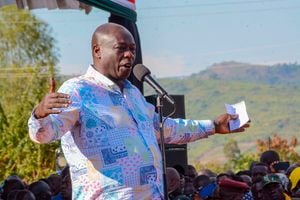Let Argentina emulate France on black players

France’s Eduardo Camavinga (25) and Argentina’s Lionel Messi during the 2022 World Cup.
The next Fifa World Cup is four years away. Argentina are the new champions, having won last year’s edition in Qatar.
Some controversy, though: There had been a debate going into, during and even after the tournament.
Argentina is geographically located in a region that has had a significant population of Black people for close to six centuries, thanks, largely, to the diabolical enterprise of slavery.
Brazil, for instance, has the world’s second-largest black population after Nigeria. But it consistently doesn’t have black players on its national football team. This has seen football fans, particularly in Sub-Saharan Africa, characterise the Latin American nation as racist.
The truth, though, is that Argentina has had black people among its population since the early 16th Century. In the 18th and 19th Centuries, blacks made up half of the population in some of the big cities. They even fought and died in its wars, including the 1810-1818 Argentine War of Independence.
A number of factors, though, are said to have led to a steady decline in the black population. In the wars, Afro-Argentines, or “Turk heads”, suffered massive casualties on the frontline. And medical emergencies, including cholera epidemics in 1861 and 1864, and a yellow fever epidemic in 1871, are partly blamed for the dwindling black population.
Other factors include the fact that the Constitution only recognises the part-European heritage of Argentina’s population and blacks are “forced” to “miscegenate themselves out of black-ness” with a view to making the country an all-white nation.
Population numbers
And while it may be true that Afro-Argentines, who mostly live in near-squalid conditions, might have been partially wiped out by a relatively higher infant mortality rate, claims by blacks that the government deliberately understates their population numbers during the census have a ring of credibility. It’s highly unlikely that, as stated in the 2010 census report, the country had only 149,493 black people.
State policy discourages the teaching of black history in schools yet there’s evidence of blacks’ incalculable contribution to the country’s cultural identity, including the region’s world-famous tango dance.
It’s nearly impossible, reportedly, for black folks, especially women, to pursue glamour-tinged careers—such as law, medicine, engineering and architecture—as they are systemically condemned to “conventionally low-class occupations”, preferably as nannies. And the free practice and celebration of culture by blacks is all but outlawed in a seemingly conspiratorial official denial of history.
Evidence shows that the country’s black football players people teams in the region’s domestic leagues, including Brazil’s.
And if what the black players in the French national football team have shown us since 1998 is anything to go by, Argentina could benefit hugely from the greater contribution of its black population, if only it can embrace history and forge greater racial and ethnic integration.
Mr Baraza, a historian, is the founder of Public Affairs Volunteers for Global Peace and Climate Justice (PAVGPCJ). [email protected].





